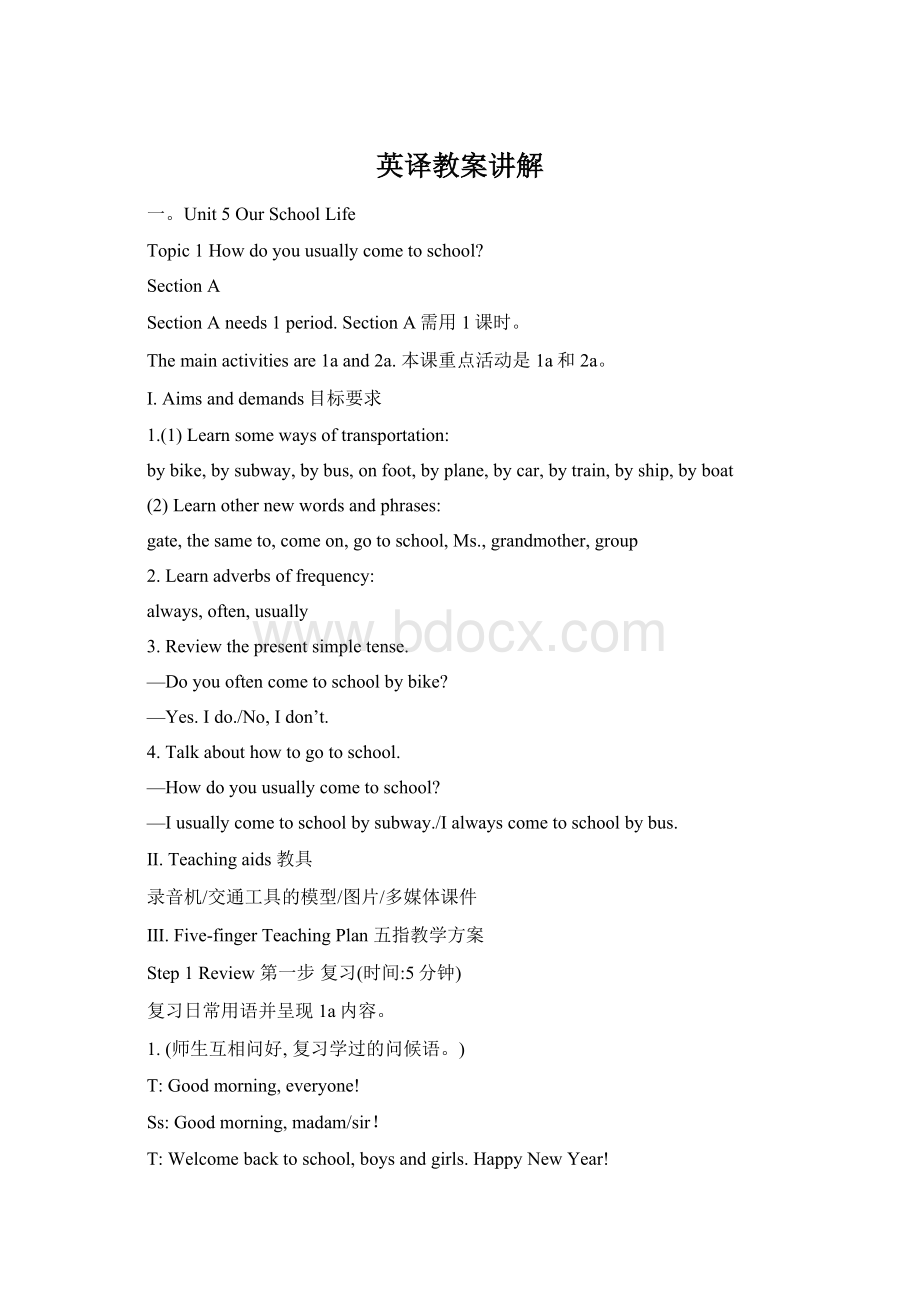英译教案讲解Word文档格式.docx
《英译教案讲解Word文档格式.docx》由会员分享,可在线阅读,更多相关《英译教案讲解Word文档格式.docx(9页珍藏版)》请在冰豆网上搜索。

1.(师生互相问好,复习学过的问候语。
)
T:
Goodmorning,everyone!
Ss:
Goodmorning,madam/sir!
Welcomebacktoschool,boysandgirls.HappyNewYear!
(教师帮助学生回答。
HappyNewYear!
Wecanalsosay,“Thesametoyou!
”
(板书)
HappyNewYear!
新年好!
Thesametoyou!
你也一样。
(新年好!
2.(用事先准备好的模型、教学图片或简笔画给学生展示bike,由此导入本课重点:
交通方式。
如下图。
Step2Presentation第二步呈现(时间:
10分钟)
学习1a,完成1b。
1.(用同样的方式教学其他交通工具,并板书相关词组。
bybike,bycar,onfoot,bysubway,bybus,byship,byboat,byplane,bytrain
(1)(熟读板书的词组。
(2)(用上面的简笔画和词组,让学生看1b的图片并模仿例句造句:
Example:
Icometoschoolbybus.
S1:
Icometoschoolbybike.
S2¬
:
Igotoschoolonfoot.
(完成1b,板书gotoschool。
gotoschool
(3)(询问两名学生上学所使用的交通方式,用usually,always和often作替换练习,并示范汇报结果。
Ioftencometoschoolbybike.Doyouoftencometoschoolbybike?
S3:
Yes,Ido.
S4,doyouusuallycometoschoolbybus?
S4:
No,Idon’t.Iusuallycometoschoolonfoot.
…
Good.S3oftencomestoschoolbybike.S4usuallycomestoschoolonfoot.S5alwayscomestoschoolbybus…OK.Workingroupsofthreetopracticelikethat.
(板书画线部分)
Doyouoftencometoschoolbybike?
Yes,Ido./No,Idon’t.
usually,always,often
2.(呈现1a并学习对交通方式的提问。
(1)(让学生听1a的录音,回答下列问题。
(1)WheredoKangkang,JaneandHelenmeet?
(2)HowdoesHelenusuallycometoschool?
(3)HowdoesJanealwayscometoschool?
Now,let’slistentothetapeandfindouttheanswerstothesequestions.Areyouready?
Yes.
OK,let’sbegin.
(播放录音。
(2)(核对答案,提取重点句型。
Whocananswerthefirstquestion?
Ican.Theymeetattheschoolgate.
Welldone.WhatabouttheanswertoQuestion2?
S2:
Helenusuallycomestoschoolbysubway.
Good.Nextquestion?
Janealwayscomestoschoolbybus.
Goodjob.
(板书画线部分。
attheschoolgate,cometo
Step3Consolidation第三步巩固(时间:
巩固1a,完成1c。
1.(再播放1a的录音,跟读并模仿语音和语调。
Listentothetapeandfollowit.Payattentiontoyourpronunciationandintonation.
2.(人机对话,即学生和录音机对话,提高学生兴趣。
Now,supposeyouareHelenandJane.Listentothetape,andmakeadialogwith
Kangkang.Areyouclear?
3.(完成1c,让学生三人一组,练习1a的对话。
要求他们仿照1a与同伴编类似的对话。
Now,boysandgirls,pleasepractice1aingroupsofthreeandmakesimilardialogswithyourpartners.ThenIwillasksomegroupstoactthemout.
4.(选几组表演他们的成果。
Whichgroupcanactyourdialogout?
G1:
Wecan.(表演对话。
Wonderful!
Anyoneelse?
G2:
…
(对学生的表演进行点评,并适当鼓励,必要时纠正学生对话中存在的错误。
Step4Practice第四步练习(时间:
完成2a和2b。
1.(让学生将2a中图片与相应的短语连线。
Justnowwetalkedaboutthemeansoftransportation.Nowlet’slookatthepicturesin2a.Thenmatchthepictureswiththecorrespondingphrases.Doyouunderstand?
Yes,wedo.
Good.Let’sbegin!
2.(核对答案。
3.(让学生听录音,完成2b。
掌握生词Ms.和grandmother。
Next,wewillhavealisteningpractice.Let’sfindouthowpeoplecometoschoolorcometowork.Doyouunderstand?
(播放录音,并核对答案。
Step5Project第五步综合探究活动(时间:
15分钟)
用表达交通工具的名词和频度副词进行实践调查,完成3。
1.(使用多媒体课件、flash动画或简笔画,让学生展开想象,任意造句子,要求用上交通工具的表达用语和频度副词。
Let’slookatthepictures.I’msureyouareinterestedintheselovelypictures.Pleasemakesentencesasyoulike,anddon’tforgettousethesemeansoftransportationandadverbsoffreguency.Areyouready?
Go!
2.(让学生分组做一个关于howtocometoschool的调查报告并完成3。
调查时,强调用“Howdoyouusuallycometoschool”和“Iusuallycometoschool…”句型,掌握生词group。
Pleasereportyourresultstoyourclassmates.
Inourgroup,threestudentscometoschoolbybike…
Inourgroup…
(学习汇总完成3。
3.(家庭作业。
(1)(让学生到社会上做调查,看人们都使用哪些交通工具,哪种交通工具使用多,哪种交通工具使用少,为什么?
并根据自己的调查结果模仿3做一个表格。
(2)(预习SectionB,注意其中的频度副词。
Ⅳ.疑点探究
本课我们学习了介词by表示“用,靠;
通过,借助于(方式、手段)”时的用法。
如:
bycar,byplane,byship等。
用来表示交通方式的介词还有in和on。
inacar,onabus等。
此时交通工具前要加限定词。
但onfoot意为“步行;
走”。
foot前不需任何限定词,foot也不能用复数。
(建议:
教师可在总结课上或练习课上补充。
SectionB
SectionBneeds1period.SectionB需用1课时。
Themainactivitiesare1,2and3a.本课重点活动是1,2和3a。
Ⅰ.Aimsanddemands目标要求
1.Learnsomenewwordsandphrases:
weekday,early,bird,catch,walk,ride,park,do(one’s)homework,watchTV
2.
(1)Goonlearningadverbsoffrequency:
seldom,never,sometimes
(2)Reviewthepresentsimpletense.
Ialwaysgetupataboutsixo’clock.
LiXiangoftencomestoschoolbybike.
3.Goonlearningadverbsoffrequencyandthemeansoftransportationindifferentexpressions.
(1)Iseldomwalktoschool.
Inevergotoschoolbysubway.
(2)—HowdoesMariagohome?
—Shesometimesgoeshomebysubway./Shesometimestakesthesubwayhome.
4.Encouragethestudentstobediligent.
Theearlybirdcatchestheworm.
录音机/图片
8分钟)
用链式发问的形式复习交通方式的表达用语及相关句型导出1,呈现并学习2。
1.(链式发问。
每竖排第一个学生问其后第二个学生一个有关交通方式的问题,第二个学生回答并接着问第三个学生……以此类推。
每组2分钟时间。
问题是:
Howdoyouusuallygotoschool?
/Doyouoftengotoschoolbybus/car…?
Example:
Howdoyouusuallygotoschool?
Iusuallygotoschoolbybike.Howdoyouusuallygotoschool?
Iusuallygotoschoolbybus.Doyouoftengotoschoolbycar?
Yes,Ido./No,Idon’t.
2.(根据第1环节的实际情况,老师总结并导出对话1的语言功能目标,为下一步过渡做铺垫。
Good.NowIknowsomeofyoucometoschoolbybike,andsomecometoschoolbybus…Ioftencometoschoolonfoot.ButsometimesIcometoschoolbybike.Inevercometoschoolbybus.Butmyfatheralwaysgoestoworkbysubway.Heseldomgoestoworkbytrain.
3.(板书并讲解以下频度副词。
呈现1。
1.(通过了解学生的起床时间,引出谚语Theearlybirdcatchestheworm。
让学生猜测这句谚语的意思。
OK,boysandgirls,whattimedoyouusuallygetup?
Iusuallygetupathalfpastsix.
Yes,weshouldgotobedearlyandgetupearly.Asthesayinggoes,“Theearlybirdcatchestheworm.”Whoknowsthemeaningofthissentence?
(让学生猜测,教师板书并加以讲解,并教导学生们在学习和生活中都应该勤奋、努力。
2.(根据1的主要信息,设置听力任务,让学生带着任务听1的录音,可以提高兴趣、降低难度。
Listento1andfindouttheanswerstothesequestionsontheblackboard.
(板书问题及生词。
weekday,early,bird,catch,walk,seldom,never
(1)WhattimedoesMichaelgetuponweekdays?
(2)HowdoesMichaelusuallygotoschool?
(3)DoesSallyoftengotoschoolbysubway?
(4)Whoalwaystakesabustoschool?
3.(让学生再听一遍1的录音并核对答案。
(Keystothequestions)
(1)Hegetsupataboutsixo’clock.
(2)Heusuallygoestoschoolonfoot.
(3)No,shedoesn’t.
(4)Sallyalwaystakesabustoschool.
巩固1和2的内容。
1.(放1的录音,让学生跟读并模仿语音和语调)
Followthetapeandpayattentiontoyourpronunciationandintonation.Ready?
2.(人机对话,提高学生的兴趣。
OK.SupposeyouareMichaelandSally.ListentothetapeandmakeadialogwithHelen.
3.(在黑板上呈现关键词,让学生利用关键词造句。
never,seldom,sometimes,often,usually,always
never:
Inevergotoschoolonfoot.
呈现3a的图片,呈现同义替换,完成3b和4。
1.
(1)(呈现3a的图片,通过师生互动,让学生进一步了解和巩固语言知识。
Lookatthefirstpicture.HowdoesMariagohome?
Shegoeshomebysubway.
Yes,wecanalsosay:
shetakesthesubwayhome.
(同样的,通过谈论第2、3、4幅图,可以得到以下几个句子。
LiXiangcomestoschoolbybike./LiXiangridesabiketoschool.
Wegototheparkonfoot./Wewalktothepark.
Theygotothezoobybus./Theytakeabustothezoo.
(呈现同义替换,加强对交通工具表达方式的灵活运用。
总结并板书。
bysubway—takethesubwaybybike—rideabike
onfoot—walkbybus—takeabus
bycar—takeacarbyplane—fly
(2)(让学生听3a的录音并跟读,然后讲解频度副词的用法。
Listentothetapeandfollowit,andpayattentiontotheusageofadverbsoffrequency.
2.(让学生完成3b。
Now,talkaboutthepicturesin3awithyourpartner.
HowdoesMariagohome?
Shesometimesgoeshomebysubway./Shesometimestakesthesubwayhome.
3.(播放4的录音,让学生独立完成4并核对答案。
12分钟)
利用所学频度副词进行实践活动。
1.
(1)(让学生用Howoftendoyou…的句型,调查自己的同伴或邻近的学生,根据调查结果,写一段话,尽量使用频度副词。
Now,lookatthetable.Pleasemakeasurveyaboutyourpartnersoryourneighborsusing“Howoftendoyou…?
”Youshouldfillouttheformwithadverbsoffrequency.Atlast,writeashortpassageaccordingtotheform.Youcanbeginlikethis:
LiMingsometimesgoesshopping…
(表格如下。
Activity
NamegoshoppingwatchTVinthe
eveningwalkaftersuppergetupearly
LiMingsometimesseldomoftenalways
(2)(让几名学生汇报他们的调查结果。
2.(弹性课堂。
要求学生背一句谚语。
Proverb:
Wherethereisawill,thereisaway.有志者事竟成。
3.(班级活动。
让学生完成5。
在轻松活泼融洽的气氛中结束这节课。
4.(家庭作业。
(让学生用SectionA和SectionB中学过的重点句型写一篇五句话左右的有关自己出行方式的小短文。
学生们如果有兴趣,可以课外收集中外谚语或名人名言。
培养他们的自主学习能力和自我建构能力。
1.动词和介词短语表达交通方式的不同。
Hewalkstoschool.=Hegoestoschoolonfoot.
但不能说Heonfoottoschool,即介词短语不能作谓语。